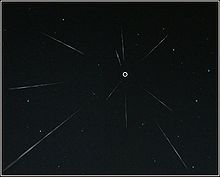Radians (astronomy)
The radiant is the point in the night sky from which meteor showers seem to begin.
The drawing shows schematically the distribution of meteor tracks in the night sky. If the traces of light are traced back, they intersect at point O , the radiant. Since the intersection of the Earth's orbit and the meteor shower only shifts slightly within the solar system , the radian is also fixed. The constellation in which it is located serves as the name for the meteor shower. For example, the radian for the Perseids is in the constellation Perseus .
Meteors in meteor streams fly parallel to each other when they meet the earth's atmosphere . The retina of the eye is tiny compared to the sky, which is why it sees the luminous phenomena in a central projection. The parallel trajectories are perceived as falling lines , just as the parallel rays of the sun appear to surround the sun radially to the eye.
As the distance from the radian increases, the mean length of the traces increases. Because these are the orbits that the observer sees from the side while the orbits near the radiant move directly towards him.
